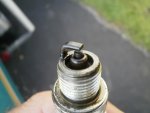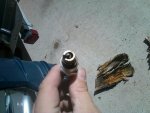Re: 1999 Johnson 250 has a ?dead spot? between 2000 and 3500-3600 RPM
Bridge....I have an engine doing the same thing. (I think).
It is a 1996 225.
Mine will begin to "stutter and miss" at around 2000 rpm, and continue this up thru about 3500, where it smoothes out.
Two things I have noticed...One is that the plugs are carbon black fouled, but not so bad that they require changing. I have changed them to new plugs, no difference tho. They are not nice brown tan like they are supposed to be.
Second, this motor will not wind up to 5500. max I can get out of it is about 4800.
Many trials, new PP, new timer base, different flywheels, timing light on all plug wires when stuttering, press key in when stuttering, all that stuff...none of it has any effect. Compression is 100 all around, carbs are spotless, and link and sync is perfect. Carbs are stock jetted. So I am fighting this also.
All this on the same boat, same loaded weight, same prop, etc. that it was running when if would flat out scream down the water.
So I ask...does yours wind up to full rpm? And what are your plugs looking like?
And, yes, that nipple in the center of the intake is capped with a rubber cap. No hoses on that one.
Bridge....I have an engine doing the same thing. (I think).
It is a 1996 225.
Mine will begin to "stutter and miss" at around 2000 rpm, and continue this up thru about 3500, where it smoothes out.
Two things I have noticed...One is that the plugs are carbon black fouled, but not so bad that they require changing. I have changed them to new plugs, no difference tho. They are not nice brown tan like they are supposed to be.
Second, this motor will not wind up to 5500. max I can get out of it is about 4800.
Many trials, new PP, new timer base, different flywheels, timing light on all plug wires when stuttering, press key in when stuttering, all that stuff...none of it has any effect. Compression is 100 all around, carbs are spotless, and link and sync is perfect. Carbs are stock jetted. So I am fighting this also.
All this on the same boat, same loaded weight, same prop, etc. that it was running when if would flat out scream down the water.
So I ask...does yours wind up to full rpm? And what are your plugs looking like?
And, yes, that nipple in the center of the intake is capped with a rubber cap. No hoses on that one.





















